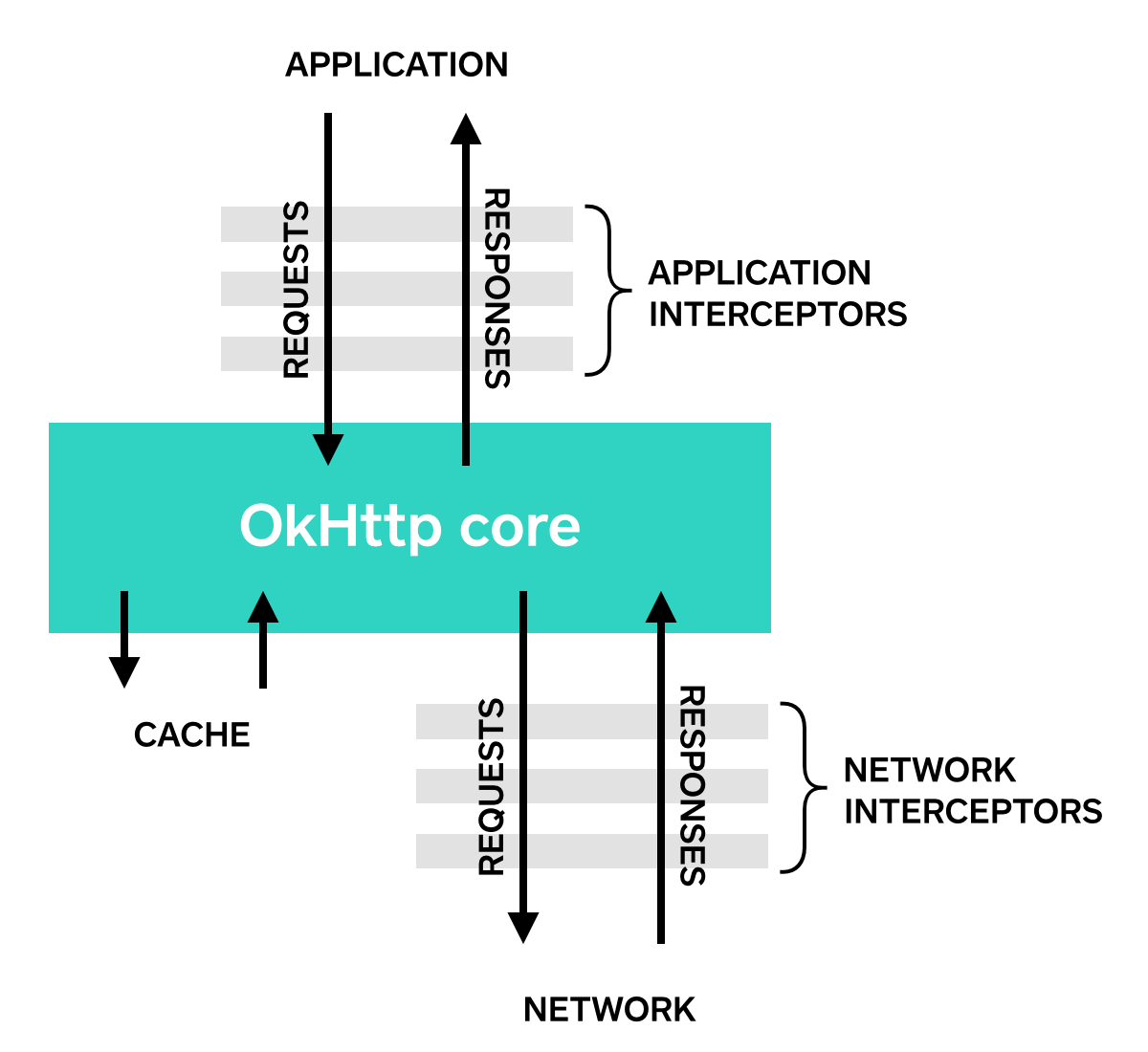Interceptors¶
Interceptors are a powerful mechanism that can monitor, rewrite, and retry calls. Here’s a simple interceptor that logs the outgoing request and the incoming response.
class LoggingInterceptor implements Interceptor {
@Override public Response intercept(Interceptor.Chain chain) throws IOException {
Request request = chain.request();
long t1 = System.nanoTime();
logger.info(String.format("Sending request %s on %s%n%s",
request.url(), chain.connection(), request.headers()));
Response response = chain.proceed(request);
long t2 = System.nanoTime();
logger.info(String.format("Received response for %s in %.1fms%n%s",
response.request().url(), (t2 - t1) / 1e6d, response.headers()));
return response;
}
}
A call to chain.proceed(request) is a critical part of each interceptor’s implementation. This simple-looking method is where all the HTTP work happens, producing a response to satisfy the request. If chain.proceed(request) is being called more than once previous response bodies must be closed.
Interceptors can be chained. Suppose you have both a compressing interceptor and a checksumming interceptor: you’ll need to decide whether data is compressed and then checksummed, or checksummed and then compressed. OkHttp uses lists to track interceptors, and interceptors are called in order.

Application Interceptors¶
Interceptors are registered as either application or network interceptors. We’ll use the LoggingInterceptor defined above to show the difference.
Register an application interceptor by calling addInterceptor() on OkHttpClient.Builder:
OkHttpClient client = new OkHttpClient.Builder()
.addInterceptor(new LoggingInterceptor())
.build();
Request request = new Request.Builder()
.url("http://www.publicobject.com/helloworld.txt")
.header("User-Agent", "OkHttp Example")
.build();
Response response = client.newCall(request).execute();
response.body().close();
The URL http://www.publicobject.com/helloworld.txt redirects to https://publicobject.com/helloworld.txt, and OkHttp follows this redirect automatically. Our application interceptor is called once and the response returned from chain.proceed() has the redirected response:
INFO: Sending request http://www.publicobject.com/helloworld.txt on null
User-Agent: OkHttp Example
INFO: Received response for https://publicobject.com/helloworld.txt in 1179.7ms
Server: nginx/1.4.6 (Ubuntu)
Content-Type: text/plain
Content-Length: 1759
Connection: keep-alive
We can see that we were redirected because response.request().url() is different from request.url(). The two log statements log two different URLs.
Network Interceptors¶
Registering a network interceptor is quite similar. Call addNetworkInterceptor() instead of addInterceptor():
OkHttpClient client = new OkHttpClient.Builder()
.addNetworkInterceptor(new LoggingInterceptor())
.build();
Request request = new Request.Builder()
.url("http://www.publicobject.com/helloworld.txt")
.header("User-Agent", "OkHttp Example")
.build();
Response response = client.newCall(request).execute();
response.body().close();
When we run this code, the interceptor runs twice. Once for the initial request to http://www.publicobject.com/helloworld.txt, and another for the redirect to https://publicobject.com/helloworld.txt.
INFO: Sending request http://www.publicobject.com/helloworld.txt on Connection{www.publicobject.com:80, proxy=DIRECT hostAddress=54.187.32.157 cipherSuite=none protocol=http/1.1}
User-Agent: OkHttp Example
Host: www.publicobject.com
Connection: Keep-Alive
Accept-Encoding: gzip
INFO: Received response for http://www.publicobject.com/helloworld.txt in 115.6ms
Server: nginx/1.4.6 (Ubuntu)
Content-Type: text/html
Content-Length: 193
Connection: keep-alive
Location: https://publicobject.com/helloworld.txt
INFO: Sending request https://publicobject.com/helloworld.txt on Connection{publicobject.com:443, proxy=DIRECT hostAddress=54.187.32.157 cipherSuite=TLS_ECDHE_RSA_WITH_AES_256_CBC_SHA protocol=http/1.1}
User-Agent: OkHttp Example
Host: publicobject.com
Connection: Keep-Alive
Accept-Encoding: gzip
INFO: Received response for https://publicobject.com/helloworld.txt in 80.9ms
Server: nginx/1.4.6 (Ubuntu)
Content-Type: text/plain
Content-Length: 1759
Connection: keep-alive
The network requests also contain more data, such as the Accept-Encoding: gzip header added by OkHttp to advertise support for response compression. The network interceptor’s Chain has a non-null Connection that can be used to interrogate the IP address and TLS configuration that were used to connect to the webserver.
Choosing between application and network interceptors¶
Each interceptor chain has relative merits.
Application interceptors
- Don’t need to worry about intermediate responses like redirects and retries.
- Are always invoked once, even if the HTTP response is served from the cache.
- Observe the application’s original intent. Unconcerned with OkHttp-injected headers like
If-None-Match. - Permitted to short-circuit and not call
Chain.proceed(). - Permitted to retry and make multiple calls to
Chain.proceed(). - Can adjust Call timeouts using withConnectTimeout, withReadTimeout, withWriteTimeout.
Network Interceptors
- Able to operate on intermediate responses like redirects and retries.
- Not invoked for cached responses that short-circuit the network.
- Observe the data just as it will be transmitted over the network.
- Access to the
Connectionthat carries the request.
Rewriting Requests¶
Interceptors can add, remove, or replace request headers. They can also transform the body of those requests that have one. For example, you can use an application interceptor to add request body compression if you’re connecting to a webserver known to support it.
/** This interceptor compresses the HTTP request body. Many webservers can't handle this! */
final class GzipRequestInterceptor implements Interceptor {
@Override public Response intercept(Interceptor.Chain chain) throws IOException {
Request originalRequest = chain.request();
if (originalRequest.body() == null || originalRequest.header("Content-Encoding") != null) {
return chain.proceed(originalRequest);
}
Request compressedRequest = originalRequest.newBuilder()
.header("Content-Encoding", "gzip")
.method(originalRequest.method(), gzip(originalRequest.body()))
.build();
return chain.proceed(compressedRequest);
}
private RequestBody gzip(final RequestBody body) {
return new RequestBody() {
@Override public MediaType contentType() {
return body.contentType();
}
@Override public long contentLength() {
return -1; // We don't know the compressed length in advance!
}
@Override public void writeTo(BufferedSink sink) throws IOException {
BufferedSink gzipSink = Okio.buffer(new GzipSink(sink));
body.writeTo(gzipSink);
gzipSink.close();
}
};
}
}
Rewriting Responses¶
Symmetrically, interceptors can rewrite response headers and transform the response body. This is generally more dangerous than rewriting request headers because it may violate the webserver’s expectations!
If you’re in a tricky situation and prepared to deal with the consequences, rewriting response headers is a powerful way to work around problems. For example, you can fix a server’s misconfigured Cache-Control response header to enable better response caching:
/** Dangerous interceptor that rewrites the server's cache-control header. */
private static final Interceptor REWRITE_CACHE_CONTROL_INTERCEPTOR = new Interceptor() {
@Override public Response intercept(Interceptor.Chain chain) throws IOException {
Response originalResponse = chain.proceed(chain.request());
return originalResponse.newBuilder()
.header("Cache-Control", "max-age=60")
.build();
}
};
Typically this approach works best when it complements a corresponding fix on the webserver!